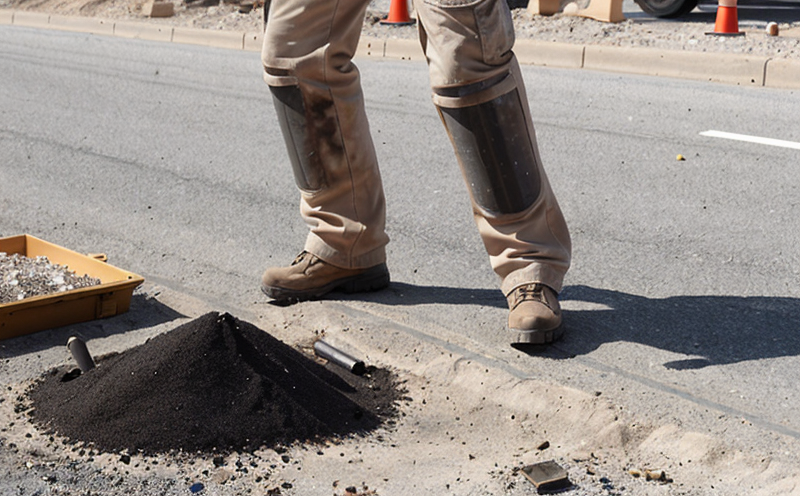DIN 20162 Detonation Velocity Measurement Testing
The DIN 20162 standard for detonation velocity measurement is a crucial test procedure in the field of explosives and blasting materials, particularly relevant to mining testing. This service ensures that blasting agents meet stringent quality requirements, which are vital for safe and efficient mining operations.
DIN 20162 defines how to measure the detonation velocity of blasting agents using a specific apparatus known as the "DIN detonation tube." The test involves determining the speed at which a detonation wave travels through the explosive material. This parameter is essential because it directly influences the blast's effectiveness, safety, and environmental impact.
The procedure outlined in DIN 20162 is rigorous and precise. It requires accurate measurement of the distance traveled by the detonation front and the time taken to traverse this distance. The formula used for calculating detonation velocity (V) is:
V = L / t
Where L represents the length of the detonation tube in meters, and t denotes the time taken by the detonation wave to travel this distance. This test ensures that the blasting agent meets the required performance standards as specified in international norms like ISO 5861.
The DIN detonation tube is a standardized device designed for this specific measurement. It consists of a metal tube with precise dimensions, ensuring consistent results across different tests. The inside of the tube must be free from any impurities or defects that could affect the accuracy of the measurement.
Proper specimen preparation is critical to ensure reliable test results. Specimens should be cut into uniform pieces and conditioned according to the standard's requirements. This includes ensuring they are at a specific moisture content, which can significantly influence detonation velocity.
The testing process itself involves placing the prepared blasting agent in the DIN detonation tube, sealing it securely, and initiating the detonation. The time taken for the detonation wave to travel through the entire length of the tube is measured precisely using high-precision timing equipment.
Accurate reporting of results according to DIN 20162 ensures that mining companies can confidently use blasting agents in their operations. Compliance with this standard helps maintain safety, efficiency, and environmental responsibility in mining activities.
| Parameter | Description |
|---|---|
| Detonation Velocity (V) | The speed at which a detonation wave travels through the blasting agent. |
| Test Apparatus | DIN detonation tube, high-precision timing equipment. |
| Specimen Preparation | Cutting into uniform pieces, conditioning to specific moisture content. |
| Data Collection | Measurement of distance and time for detonation wave travel. |
| Compliance | Ensures safe and efficient mining operations in accordance with international standards. |
This testing method is not only a regulatory requirement but also essential for advancing the field of explosives technology. By adhering to DIN 20162, manufacturers can develop safer, more effective blasting agents that meet both domestic and international safety standards.
Benefits
Implementing DIN 20162 detonation velocity measurement testing brings numerous advantages to mining operations. It ensures the quality and reliability of blasting materials, which is critical for maintaining operational efficiency and safety.
- Enhanced Safety: By ensuring that blasting agents meet strict performance criteria, this test minimizes the risk of accidents during mining operations.
- Efficiency: Reliable blasting materials lead to more efficient and effective mine excavation processes.
- Regulatory Compliance: Adherence to international standards like DIN ensures compliance with regulatory requirements.
- Environmental Responsibility: Precise detonation velocity measurement helps in optimizing blast design, reducing unnecessary energy consumption and environmental impact.
The rigorous testing process also fosters innovation within the industry by providing a benchmark for continuous improvement. By adhering to such standards, mining companies can contribute to safer and more sustainable operations.
Industry Applications
| Industry | Description of Application |
|---|---|
| Mining | Determining the effectiveness and safety of blasting agents used in mine excavation. |
| Blasting Contractors | Evaluating blasting materials for safe and efficient project execution. |
| Construction | Ensuring compliance with safety regulations during demolition or construction activities involving explosives. |
| R&D Engineers | Testing new formulations of blasting agents to ensure they meet the required performance standards. |
| Quality Managers | Verifying that production batches of blasting materials comply with specified quality parameters. |
| Safety Officers | Evaluating the safety profile of different blasting agents for use in various mining environments. |
The DIN 20162 detonation velocity measurement testing is widely used across these industries to ensure that blasting agents meet stringent quality and safety standards. This ensures safer, more efficient operations while minimizing environmental impact.
Environmental and Sustainability Contributions
- Energy Efficiency: Precise detonation velocity measurement helps in optimizing blast design, reducing unnecessary energy consumption.
- Reduction of Emissions: By ensuring the most effective use of blasting materials, this testing minimizes the environmental footprint associated with mining activities.
- Better Resource Management: Reliable test results lead to more efficient use of resources, contributing to overall sustainability goals.
- Minimized Waste: Precise detonation velocity measurement aids in minimizing waste generation during blasting operations.
The DIN 20162 detonation velocity measurement testing plays a vital role in promoting sustainable mining practices. By ensuring that only the most effective and environmentally friendly materials are used, this service contributes significantly to environmental stewardship and sustainability initiatives in the mining industry.





